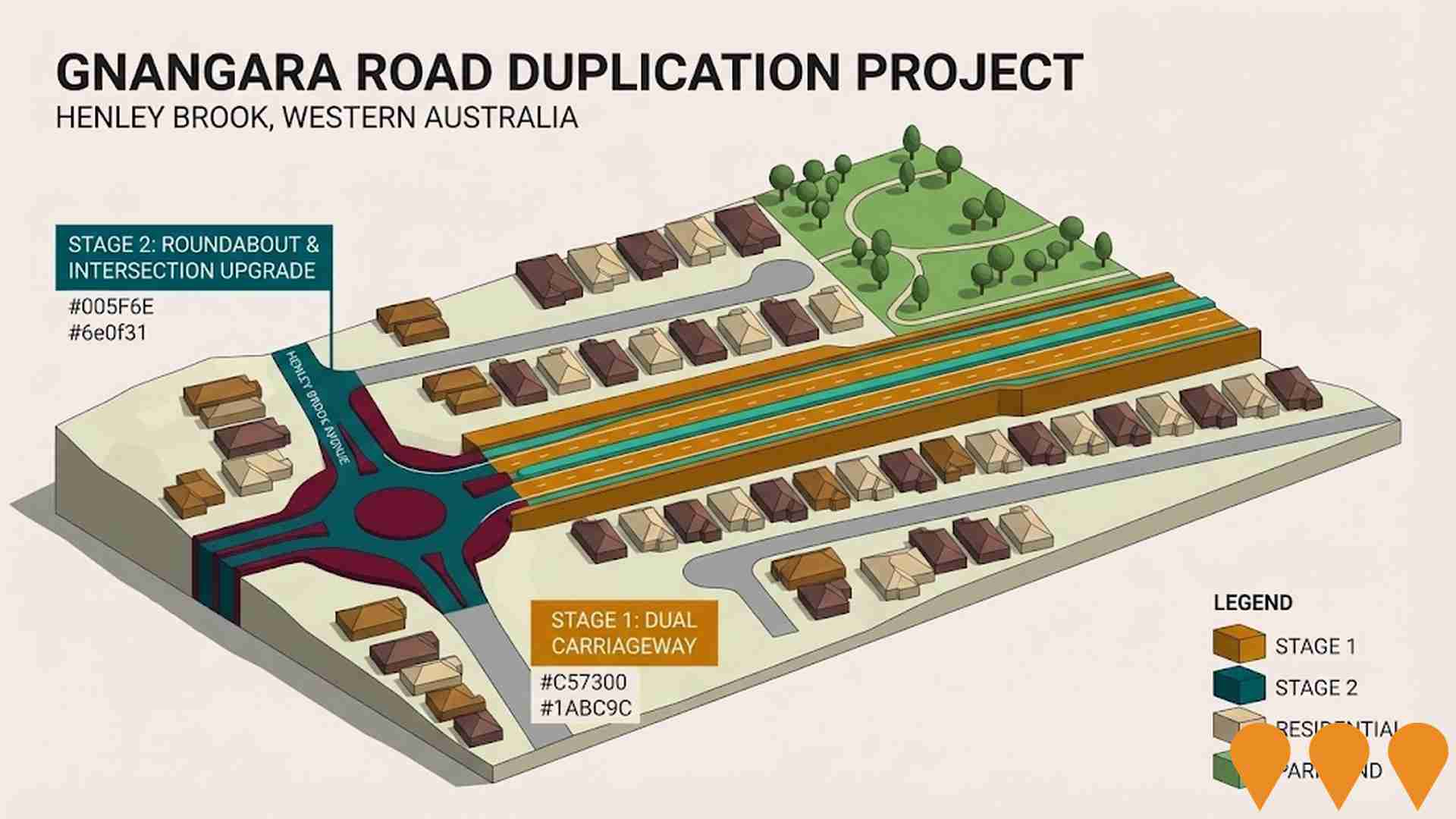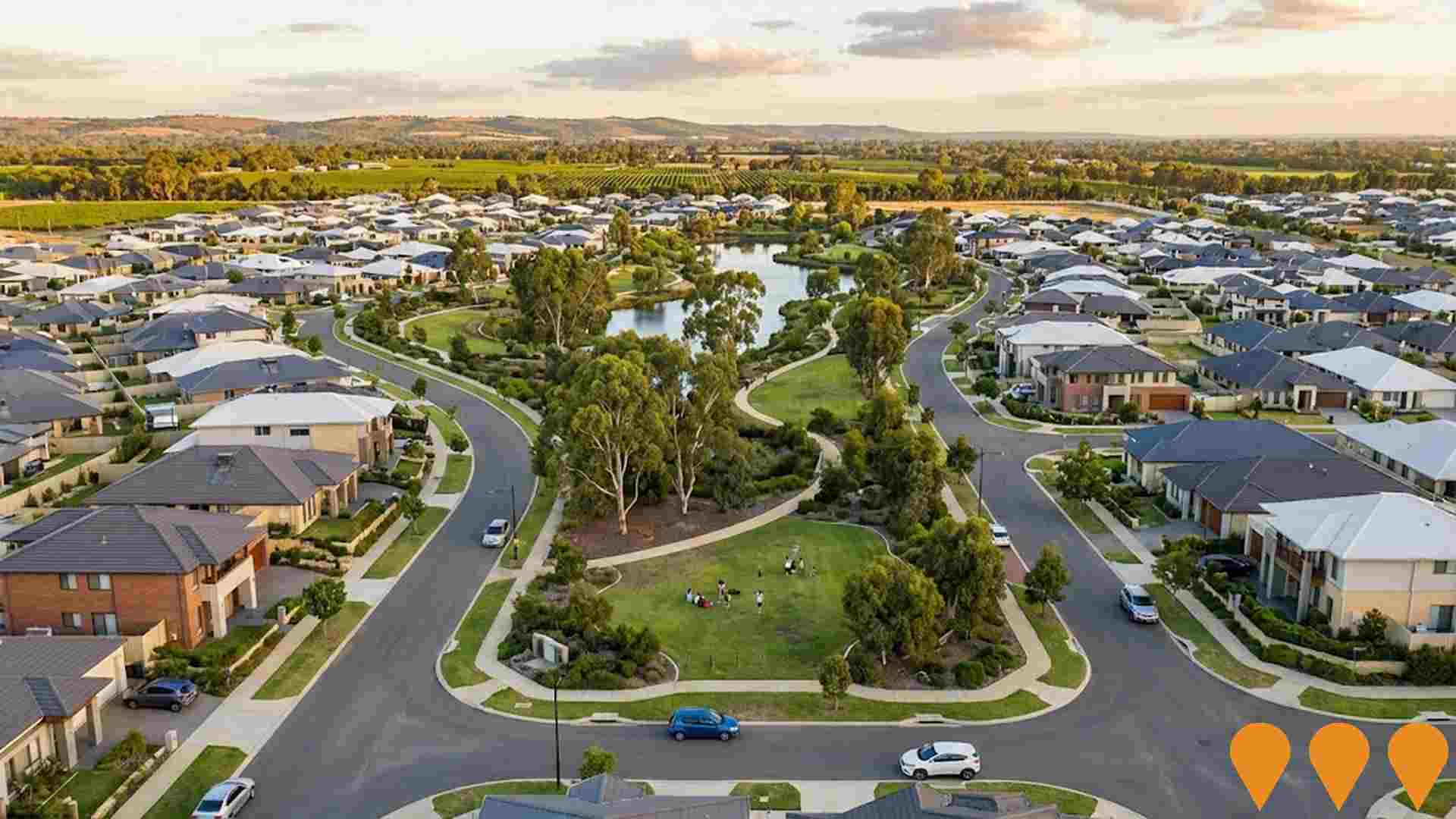Chart Color Schemes
est. as @ -- *
ABS ERP | -- people | --
2021 Census | -- people
Sales Activity
Curious about local property values? Filter the chart to assess the volume and appreciation (including resales) trends and regional comparisons, or scroll to the map below view this information at an individual property level.
Find a Recent Sale
Sales Detail
Population
Aveley lies within the top 10% of areas nationally in terms of population growth performance according to AreaSearch analysis of short and medium-term trends
Aveley's population is around 18,885 as of Aug 2025. This reflects an increase of 3,205 people from the 2021 Census figure of 15,680 people. The change is inferred from ABS estimated resident population data: 18,887 in June 2024 and an additional 173 validated new addresses since the Census date. Population density is 2,797 persons per square kilometer, placing Aveley in the upper quartile nationally according to AreaSearch assessments. Since the 2021 Census, Aveley's population growth of 20.4% exceeded both national (8.6%) and state averages, marking it as a growth leader in the region. Interstate migration contributed approximately 45.4% of overall population gains during recent periods.
AreaSearch uses ABS/Geoscience Australia projections for each SA2 area, released in 2024 with a base year of 2022. For areas not covered by this data and post-2032 growth estimates, AreaSearch utilises ABS Greater Capital Region projections released in 2023 based on 2022 data. Future population trends forecast a significant increase in Aveley's top quartile statistical areas, with an expected rise of 5,801 persons to 2041, representing a total increase of 30.7% over the 17 years.
Frequently Asked Questions - Population
Development
AreaSearch assessment of residential development activity positions Aveley among the top 25% of areas assessed nationwide
Aveley has seen approximately 172 new homes approved annually. Over the past five financial years, from FY-21 to FY-25, around 861 homes were approved, with an additional two approved in FY-26 so far. On average, about 4.9 people have moved to the area each year for every dwelling built during these years.
This high demand outpaces new supply, typically leading to price growth and increased buyer competition. The average construction cost value of new homes is around $385,000, aligning with regional patterns. In FY-26, commercial development approvals totalled $3.2 million, indicating limited focus on commercial development in the area. Compared to Greater Perth, Aveley has 16.0% lower construction activity per person.
Nationally, it ranks at the 35th percentile of areas assessed, offering more limited housing choices for buyers and supporting demand for existing properties. New developments in Aveley consist predominantly of detached dwellings (91.0%) with a smaller proportion of medium and high-density housing (9.0%), maintaining the area's traditional suburban character focused on family homes. The population density stands at approximately 522 people per dwelling approval, reflecting an established area. Looking ahead, Aveley is projected to grow by 5,803 residents by 2041. With current construction levels, housing supply should meet demand adequately, creating favourable conditions for buyers and potentially enabling growth that exceeds current forecasts.
Frequently Asked Questions - Development
Infrastructure
Aveley has emerging levels of nearby infrastructure activity, ranking in the 28thth percentile nationally
Changes to local infrastructure significantly impact an area's performance. AreaSearch has identified ten projects likely affecting this region. Notable ones are Stockland Vale Aveley, Stockland Vale in Aveley, Swan Active Ellenbrook Recreation & Aquatic Centre, and Vale Estate (Aveley). The following list details those expected to have the most relevance.
Professional plan users can use the search below to filter and access additional projects.
INFRASTRUCTURE SEARCH
 Denotes AI-based impression for illustrative purposes only, not to be taken as definitive under any circumstances. Please follow links and conduct other investigations from the project's source for actual imagery. Developers and project owners wishing us to use original imagery please Contact Us and we will do so.
Denotes AI-based impression for illustrative purposes only, not to be taken as definitive under any circumstances. Please follow links and conduct other investigations from the project's source for actual imagery. Developers and project owners wishing us to use original imagery please Contact Us and we will do so.
Frequently Asked Questions - Infrastructure
Ellenbrook Town Centre Development
A 157.7ha town centre development, part of the wider Ellenbrook master-planned community. It is planned to include approximately 1,800 dwellings, 205,788m2 of commercial space, retail, education, and community facilities, establishing a major regional employment and commercial hub. The development is being undertaken in stages and includes key elements like the Ellenbrook Station Precinct, which is zoned for future urban development with a mix of housing, employment, and community uses.
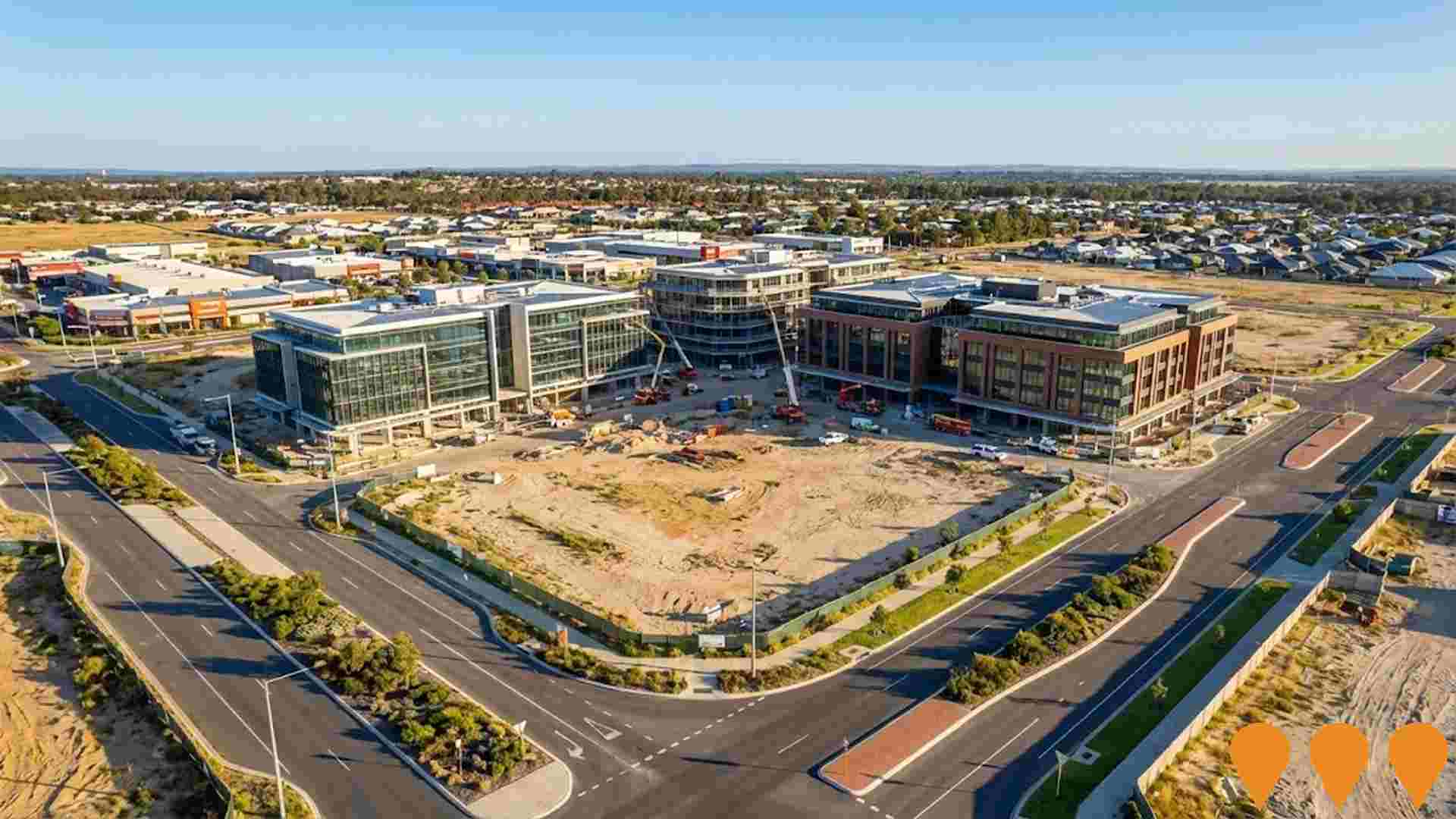
North Ellenbrook (West) District Structure Plan
Approved district structure plan setting the strategic framework for urbanisation of the North Ellenbrook West growth area in the City of Swan. The Western Australian Planning Commission has endorsed the East and West district structure plans as the basis for further detailed planning and investigation, with Amendment 1 to the West DSP adding around 163 hectares of additional urban land and planning for up to 7,500 residents. The West DSP provides for roughly 4,000 to 4,500 new dwellings, associated schools, activity centres, employment land, public open space and environmental corridors, supported by Metropolitan Region Scheme amendments that rezone about 393 hectares from Rural to Urban Deferred and Parks and Recreation. Parcel Property has led structure planning for the West, while private developers including Wolfdene and Oreana have acquired a 72 hectare site earmarked for about 800 lots and around 2,000 residents, with retail launches and initial construction targeted from 2029. The broader precinct will be linked to Tonkin Highway and the Ellenbrook METRONET station, forming a major new masterplanned community and employment node in Perths north east corridor.

Stockland Vale Aveley
Award-winning masterplanned community in Aveley, Western Australia, spanning 5,235 residential lots and featuring town centres, three schools, parks, and major recreational facilities. The development integrates with existing bushland, wetlands, and the Swan Valley character, and is one of the fastest-growing corridors in Western Australia. Land and house & land packages are currently for sale.
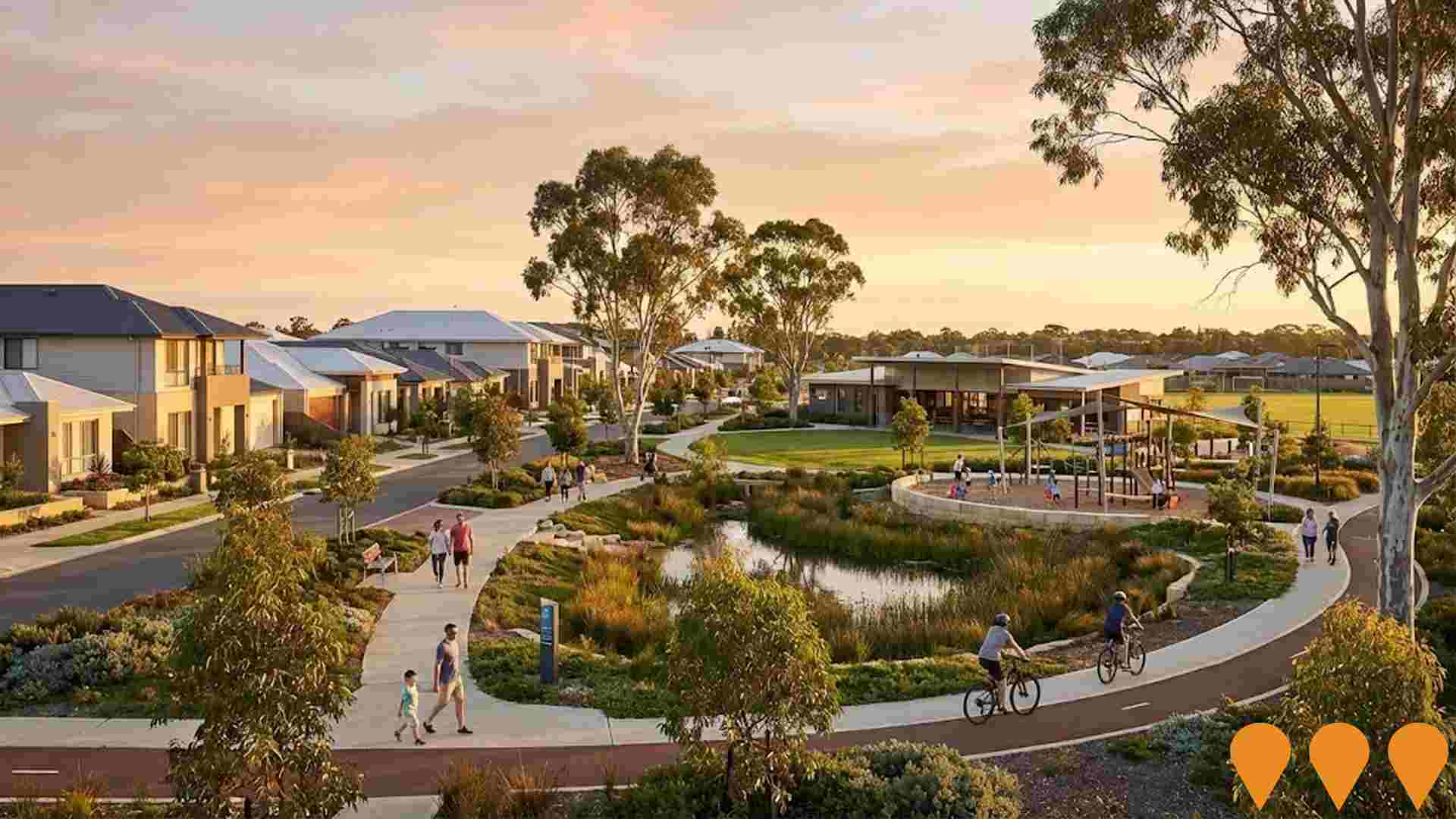
Ellenbrook Central Shopping Centre Stage 3 Expansion
$63 million expansion completed in 2021, adding a new Kmart and 20 additional retailers, expanding by 11,000 sqm and creating 380 new retail jobs. The centre now totals 47,000 sqm with over 85 specialty stores, anchored by Big W, Kmart, ALDI, Coles, and Woolworths, serving the Ellenbrook-Brabham region and a trade area population of 84,054 with 5.1 million annual visits.
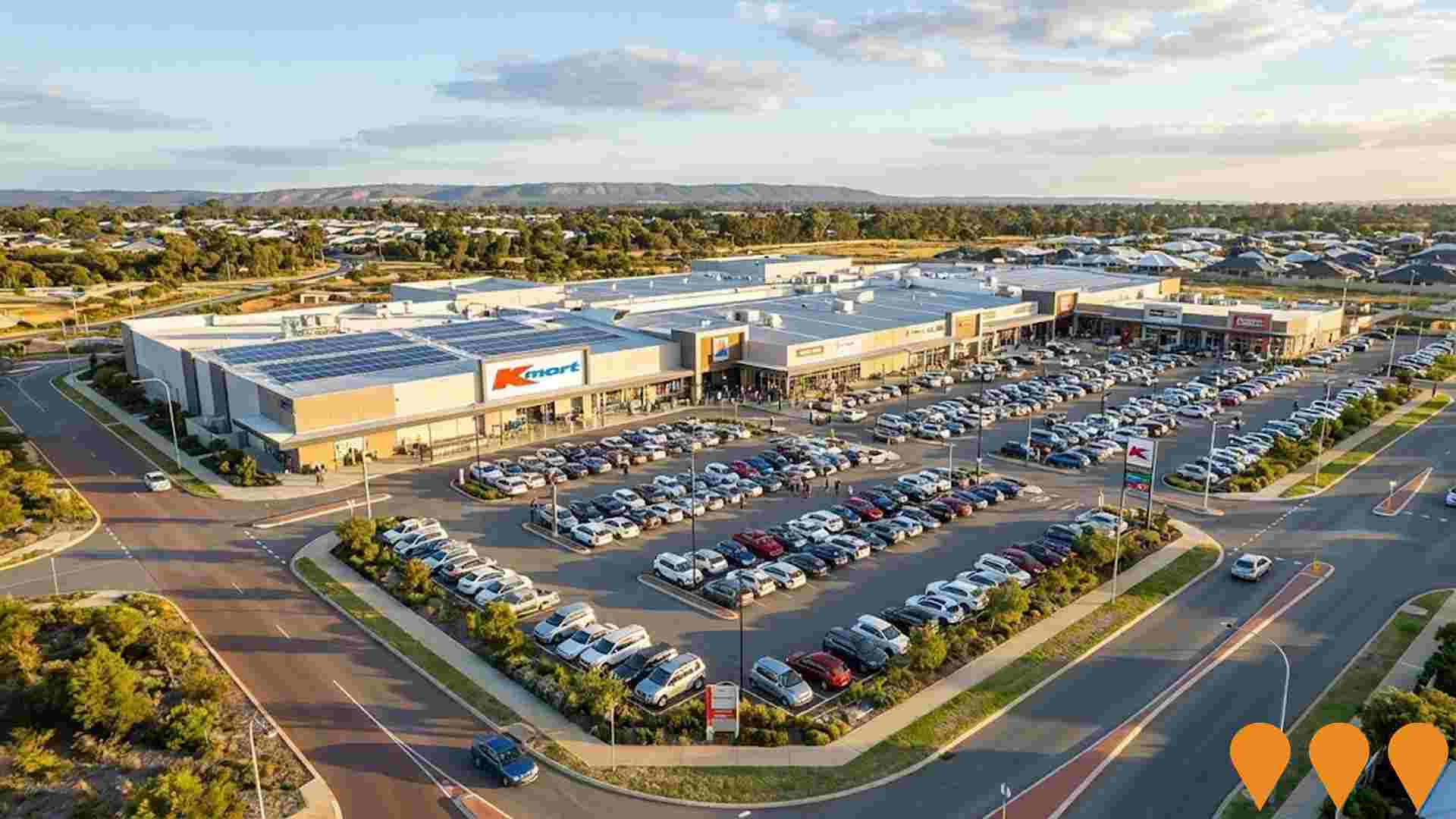
Dayton District Open Space
A 15ha community recreation precinct with sports pavilions, youth facilities, AFL and cricket ovals, synthetic and grass hockey fields, multi-use/netball courts, play spaces and a family hub serving the Swan Urban Growth Corridor. Stage 2 reached practical completion in 2024 and the site is open for community use.
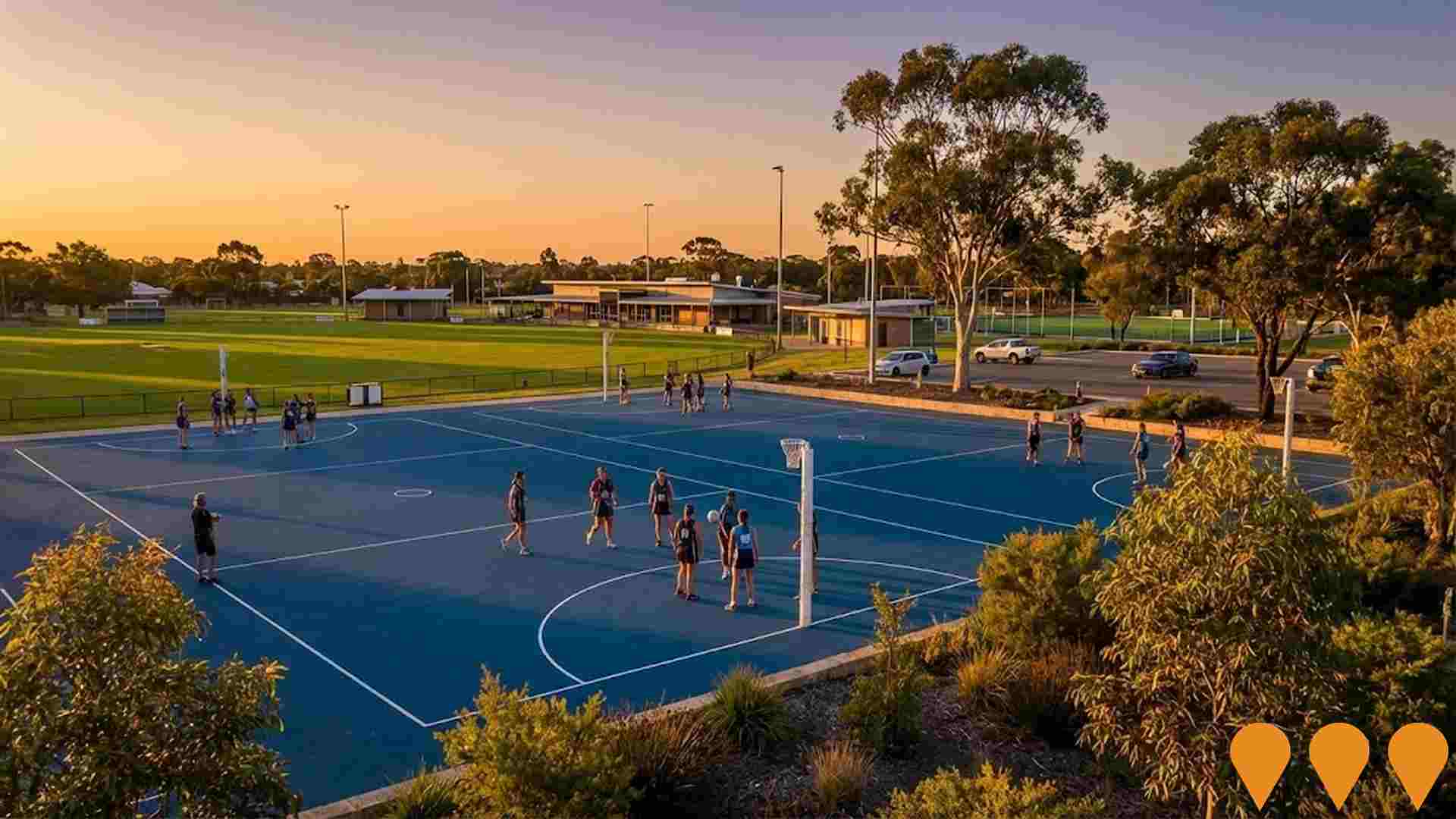
Ellenbrook Railway Station
Terminus station on the Ellenbrook Line (formerly Morley-Ellenbrook Line) with a 150 m island platform, about 500 parking bays, a 12-stand bus interchange, full accessibility and integrated town centre connections. Station opened in December 2024 as part of the new Ellenbrook Line connecting Ellenbrook to Bayswater and the broader Transperth network.

Swan Active Ellenbrook Recreation & Aquatic Centre
Regional-level aquatic and recreation facility adjacent to Ellenbrook train station. Features 50m pool, 25m pool, warm water pools, toddler pools, four waterslides, grandstand, change rooms, shaded barbeque and picnic areas, sports hall with indoor multi-purpose courts, gym and fitness centre, wellness centre, creche, kiosk with kitchen facilities. Honorary name: Margaret Kidson Leisure Centre. $120m investment with sustainable design achieving 5-Star Green Star equivalent rating. Earthworks completed in May 2025, main construction tender under review as of August 2025.

Aveley Secondary College Expansion
Expansion of Aveley Secondary College facilities to accommodate growing student population in the Ellenbrook/Aveley corridor. Additional classrooms, laboratories, and recreational facilities to support educational excellence.
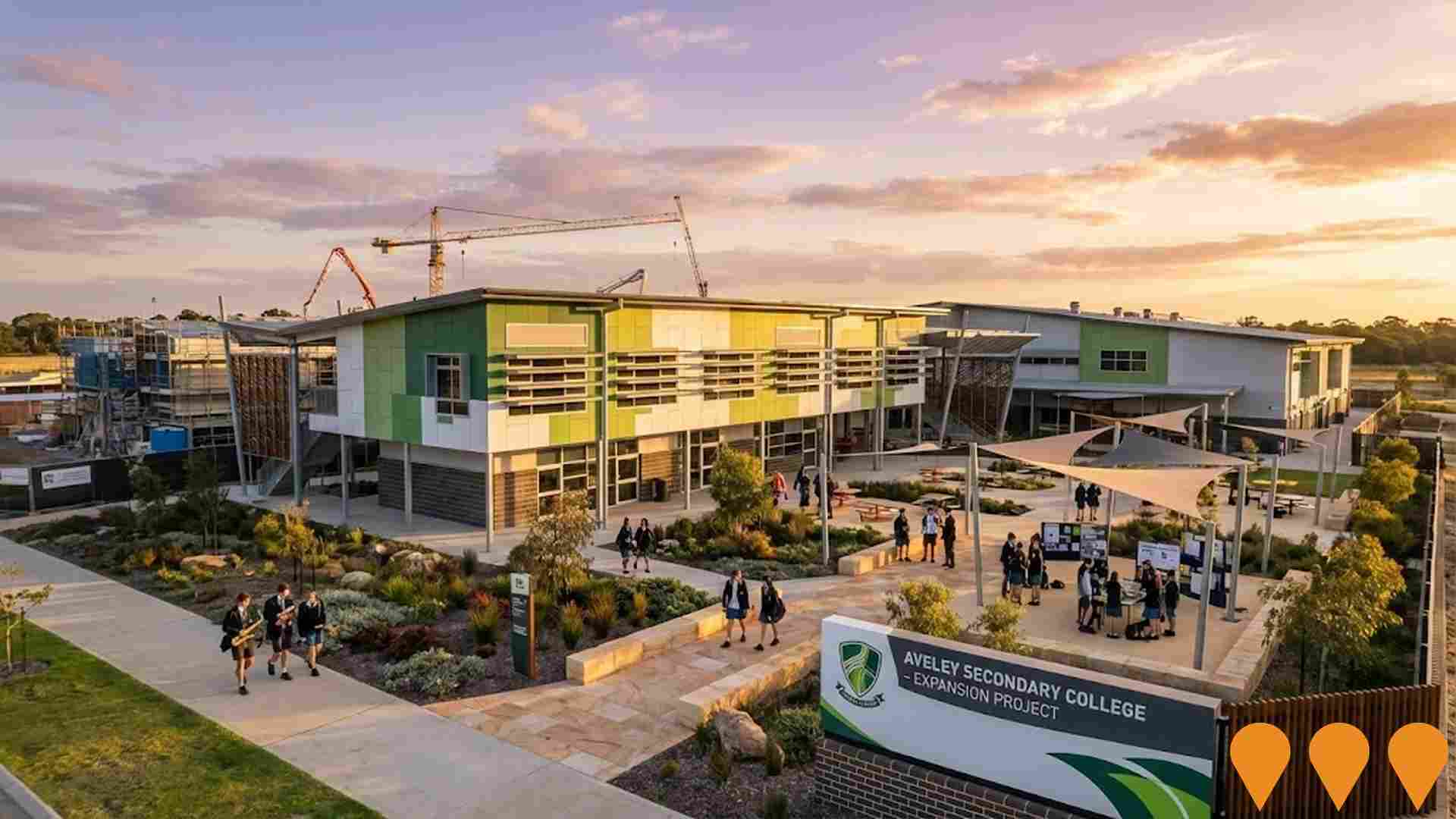
Employment
AreaSearch analysis of employment trends sees Aveley performing better than 90% of local markets assessed across Australia
Aveley has a skilled workforce with strong representation in manufacturing and industrial sectors. The unemployment rate is 2.1%.
Over the past year, there was an estimated employment growth of 3.8%. As of June 2025, 11,530 residents are employed, with an unemployment rate of 1.7% below Greater Perth's rate of 3.9%. Workforce participation is high at 76.6%, compared to Greater Perth's 65.2%. Key industries include health care & social assistance, retail trade, and construction.
Retail trade has a significant share of employment at 1.2 times the regional level. However, professional & technical services employ only 4.5% of local workers, below Greater Perth's 8.2%. Employment opportunities may be limited locally, as indicated by Census data. Between June 2024 and June 2025, employment levels increased by 3.8%, while the labour force grew by 4.1%, causing unemployment to rise by 0.3 percentage points. In Greater Perth, employment rose by 3.7% and unemployment rose by 0.1 percentage points during the same period. Jobs and Skills Australia's national employment forecasts from May 2025 suggest that Aveley's employment could grow by approximately 6.0% over five years and 12.9% over ten years, based on a simple weighting extrapolation of industry-specific projections.
Frequently Asked Questions - Employment
Income
Income metrics indicate excellent economic conditions, with the area achieving higher performance than 75% of national locations assessed by AreaSearch
AreaSearch aggregated latest postcode level ATO data released for financial year 2022. Aveley had a median income among taxpayers of $67,317 and an average income of $80,549. These figures were among the highest in Australia, compared to Greater Perth's median of $58,380 and average of $78,020. Based on Wage Price Index growth of 14.2% since financial year 2022, current estimates for Aveley would be approximately $76,876 (median) and $91,987 (average) as of September 2025. Census data shows household, family, and personal incomes in Aveley rank highly nationally, between the 75th and 81st percentiles. The predominant income cohort spans 44.5% of locals (8,403 people), falling within the $1,500 - 2,999 category, mirroring the metropolitan region where 32.0% occupy this bracket. High housing costs consume 17.9% of income in Aveley, but strong earnings place disposable income at the 72nd percentile nationally. The area's SEIFA income ranking places it in the 6th decile.
Frequently Asked Questions - Income
Housing
Aveley is characterized by a predominantly suburban housing profile, with ownership patterns similar to the broader region
The dwelling structure in Aveley, as per the latest Census, consisted of 92.9% houses and 7.1% other dwellings. In comparison, Perth metro had 89.1% houses and 10.9% other dwellings. Home ownership in Aveley was at 11.9%, with mortgaged dwellings at 68.2% and rented ones at 19.9%. The median monthly mortgage repayment in Aveley was $1,950, higher than Perth metro's $1,842. The median weekly rent in Aveley was $380, compared to Perth metro's $340. Nationally, Aveley's mortgage repayments were higher at $1,950 versus the Australian average of $1,863, and rents were also higher at $380 compared to the national figure of $375.
Frequently Asked Questions - Housing
Household Composition
Aveley features high concentrations of family households, with a higher-than-average median household size
Family households account for 81.1% of all households, including 43.8% couples with children, 22.6% couples without children, and 13.7% single parent families. Non-family households make up the remaining 18.9%, with lone person households at 16.4% and group households comprising 2.5%. The median household size is 2.9 people, larger than the Greater Perth average of 2.8.
Frequently Asked Questions - Households
Local Schools & Education
Aveley performs slightly above the national average for education, showing competitive qualification levels and steady academic outcomes
Educational qualifications in Aveley trail regional benchmarks with 20.9% of residents aged 15+ holding university degrees compared to 30.4% nationally as of 2021. This gap highlights potential for educational development and skills enhancement. Bachelor degrees lead at 15.1%, followed by postgraduate qualifications (3.8%) and graduate diplomas (2.0%). Trade and technical skills are prominent, with 42.6% of residents aged 15+ holding vocational credentials – advanced diplomas (12.6%) and certificates (30.0%).
Educational participation is high at 32.9%, including 13.1% in primary education, 9.1% in secondary education, and 3.6% pursuing tertiary education as of the latest data from 2021. Aveley's 4 schools had a combined enrollment of 4,223 students while demonstrating typical Australian school conditions (ICSEA: 1011) with balanced educational opportunities. The educational mix includes 2 primary, 1 secondary, and 1 K-12 school. School capacity exceeds typical residential needs (22.4 places per 100 residents vs 15.7 regionally), indicating the area serves as an educational center for the broader region.
Frequently Asked Questions - Education
Schools Detail
Nearby Services & Amenities
Transport
Transport servicing is moderate compared to other areas nationally based on assessment of service frequency, route connectivity and accessibility
Public transport analysis reveals 81 active transport stops operating within Aveley. These are a mix of bus stops serviced by 9 individual routes. Collectively, they provide 1,999 weekly passenger trips.
Transport accessibility is rated excellent with residents typically located 191 meters from the nearest stop. Service frequency averages 285 trips per day across all routes, equating to approximately 24 weekly trips per stop.
Frequently Asked Questions - Transport
Transport Stops Detail
Health
Aveley's residents boast exceedingly positive health performance metrics with younger cohorts in particular seeing very low prevalence of common health conditions
Health outcomes data shows excellent results in Aveley, with younger cohorts experiencing a very low prevalence of common health conditions. Approximately 60% of Aveley's total population (11,293 people) has private health cover, compared to 54.1% across Greater Perth.
The most prevalent medical conditions are asthma and mental health issues, affecting 7.7% and 7.7% of residents respectively. 76.8% of Aveley residents report being completely clear of medical ailments, compared to 72.6% in Greater Perth. As of the data, Aveley has 8.2% of its population aged 65 and over (1,539 people), lower than Greater Perth's 12.6%.
Frequently Asked Questions - Health
Cultural Diversity
Aveley was found to be more culturally diverse than the vast majority of local markets in Australia, upon assessment of a range of language and cultural background related metrics
Aveley was found to have a higher cultural diversity than most local markets, with 23.1% of its population speaking languages other than English at home and 36.4% born overseas. Christianity is the predominant religion in Aveley, making up 42.6% of its population. Notably, the 'Other' category comprises 3.1% of Aveley's population, compared to 2.4% across Greater Perth.
In terms of ancestry, the top three groups are English (26.4%), Australian (22.3%), and Other (13.6%). Some ethnic groups show significant differences: Maori is overrepresented at 1.8%, South African at 1.4%, and New Zealand at 1.1%.
Frequently Asked Questions - Diversity
Age
Aveley hosts a very young demographic, ranking in the bottom 10% of areas nationwide
Aveley's median age is 31 years, which is lower than Greater Perth's average of 37 and Australia's median of 38. Compared to Greater Perth, Aveley has a higher proportion of residents aged 5-14 years (16.1%) but fewer residents aged 65-74 years (4.9%). Between 2021 and the present, the population aged 15-24 years increased from 12.2% to 13.4%, while the 0-4 age group decreased from 9.5% to 7.6%. The 25-34 age group also declined from 18.0% to 16.5%. By 2041, Aveley's age profile is projected to change significantly. The 45-54 age cohort is expected to grow by 46%, increasing from 2,243 to 3,271 people. Meanwhile, the 5-14 age group is projected to grow by a modest 5% (150 people).

